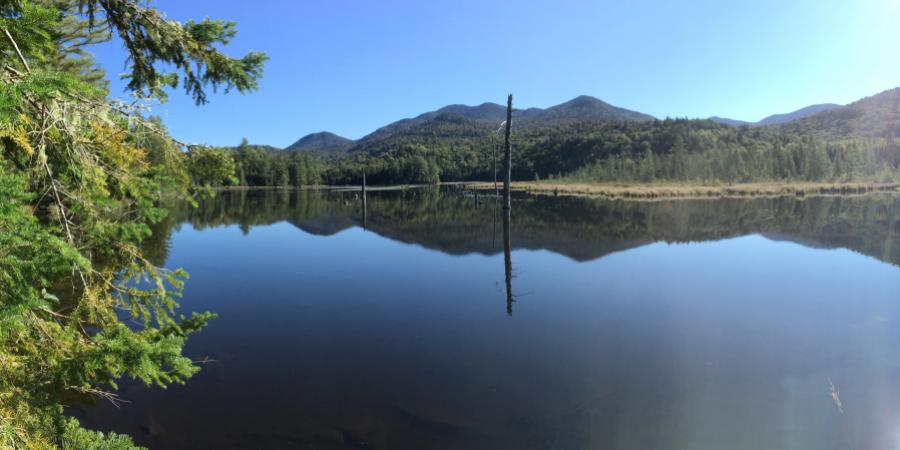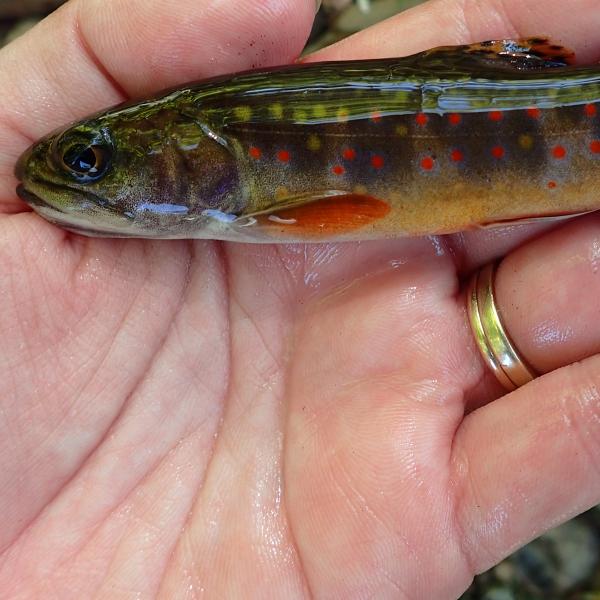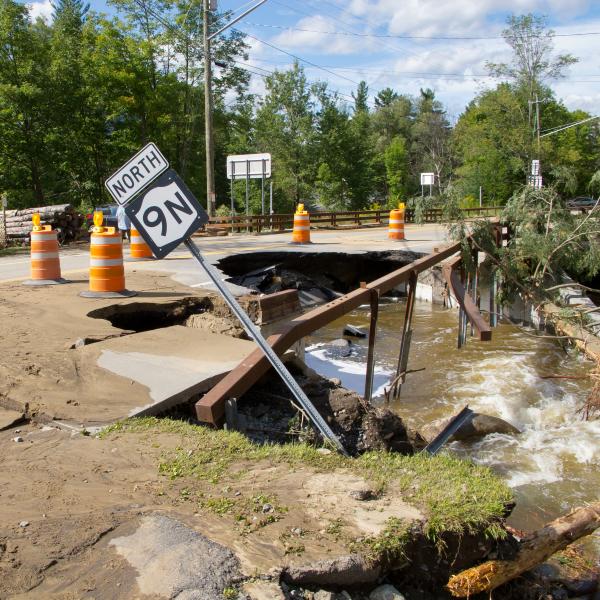The Ausable watershed is teeming with life. Diverse habitats are created by the Ausable River as it tumbles down the steep slopes from its headwaters in the High Peaks Wilderness and then meanders through the lush floodplains of its lower valleys. These habitats, in turn, host a broad array of aquatic and terrestrial species and complex ecosystems.
The Ausable River Association (AsRA) recognizes that, in addition to protecting and restoring the river, it is necessary to protect vulnerable species that are dependent on near and in-stream habitats. To protect brook trout and other aquatic life in the Ausable, we must document existing conditions, understand the threats these species face – including climate change, land use, and invasive species – and work to mitigate and prevent these threats from adversely impacting the wildlife populations. We have developed the following monitoring and research programs within the Ausable River watershed.
Documenting Climate Change Impacts on Fish Distribution
Warming air and waters threaten the survival of many native Adirondack species, especially brook trout. In addition to monitoring water temperatures and adding riparian tree cover, we are using new technologies, such as environmental DNA (eDNA), to better understand the impact of climate change on brook trout habitat suitability.
Since 2017, AsRA's scientists have been using environmental DNA to answer questions about trout distribution and habitat use. In 2021, with a grant from the Lake Champlain Basin Program (LCBP) and New England Interstate Water Pollution Prevention Council (NEIWPCC), we walked, hiked, and paddled on over 60 kilometers of the Ausable River, Chubb River, and Johns Brook collecting water samples for environmental DNA. This allowed us to see where brook trout are distributed in the headwaters of the East and West Branch Ausable Rivers and throughout the Chubb River. This work will continue in 2022.
Using New Technology to Monitor Atlantic Salmon Restoration Efforts
AsRA's science staff are also using environmental DNA to research Atlantic salmon in partnership with the U.S. Fish and Wildlife Service (USFWS). In 2021, we traversed 20 miles of the North Branch Boquet River to map Atlantic salmon and brown trout distribution. Our primary research objective is to determine whether eDNA is an effective tool for tracking salmon spawning success. We're also helping USFWS to assess spawning success of Atlantic salmon and, therefore, the overall success of restoration efforts in the Boquet River since a large dam was removed in 2015. The LCBP grant funding this research helped form a strategic partnership and sharing of technical expertise between AsRA, the U.S. Forest Service, and the USFWS. The grant also helped bring scientific advisors to the table from New York State Department of Environmental Conservation (NYSDEC), The U. S. Geological Survey (USGS), and Paul Smith's College.
Riparian Restoration and Monitoring
The Ausable River Association works to restore native grasses, plants, trees to the once lush streamside, or riparian, habitats along river and stream corridors in the watershed. Whether we're planting to increase riparian shading or establishing plants on newly restored streambanks– we focus on bringing back the diverse native plant structure that is essential to stream health and wildlife diversity. We've planted 10,000 trees in the past eleven years, and we continually assess our planting methods and species choice. We aim to find the most appropriate native species and methods that maximize revegetation success while minimizing time, energy, and money needed to maintain revegetated areas. Long-term, formal monitoring of three former restoration sites helps us to understand long-term growing success and apply additional plantings where needed. By using what we learn, we maximize the growth of the many riparian habitats we work in, the protection of streambanks, and, therefore, the long-term success of our restoration projects.
Invasive Species
Several invasive plant and animal species threaten native habitats. At the Ausable River Association, we work to identify, inventory, and remove invasive species that threaten the vulnerable native species that rely on Ausable waterways, floodplains, and wetlands. For example, we monitor current and past infestations of knotweed, purple loosestrife, and phragmites across the watershed, and survey for new invaders like Japanese tree lilac.
River Outreach and Angler Education
In addition to surveying the watershed for invasive species, our river steward brings on-river education and outreach to anglers at our most popular fishing access points from May to October. In 2021, we completed our eleventh summer of this program and had face-to-face conversations with more than 180 anglers. The river steward serves as an Ausable River Association ambassador at farmers' markets and other public events, where our reach extends to hundreds more watershed visitors and residents.
Ausable River Association's scientists provide a week of interactive science education in partnership with the Adirondack Mountain Club at our Teen Aquatic Stewardship Program. Students get opportunities to learn hands-on science investigation using macroinvertebrate sampling, where comparison of pollution-tolerant versus pollution-intolerant species helps them understand biotic integrity and the importance of clean water.
Temperature Monitoring
The Ausable River Association maintains a network of temperature data loggers in the Ausable River to provide a continuous measure of water temperature. Warmer waters threaten the survival of many native Adirondack species, most notably the iconic brook trout. Given the challenges posed by global climate change, our goal is to understand where waters are warming in the watershed, whether our restoration efforts have a cooling effect, and the long-term suitability of the Ausable and its tributaries as habitat.



